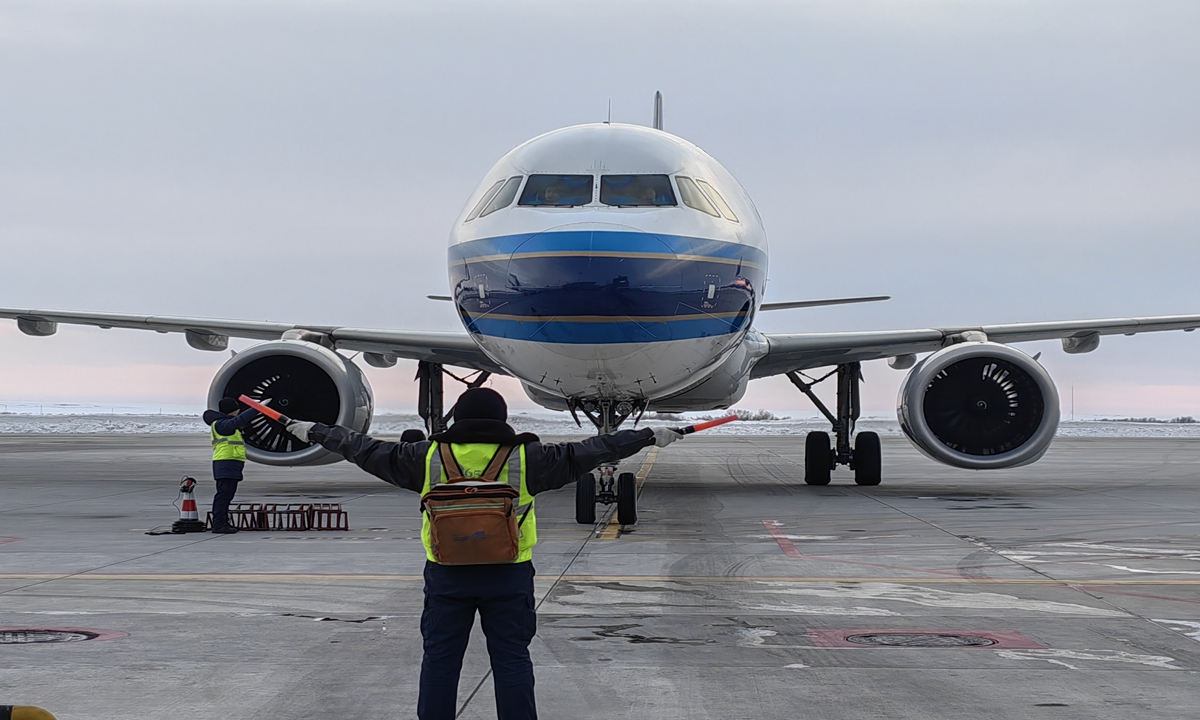
Zhu Jiangchen competes during the Snowboard Men catagory event at the 2024/25 FWT Hemu Freeride week 3 Star qualifier at the Jikepulin International Ski Resort in Altay Prefecture, northwest China's Xinjiang Uygur Autonomous Region on Dec. 7, 2024. (Photo/Xinhua)
Chinese airlines are actively exploring ice and snow routes brought on by rising demand, and official data showed that the Altay Xuedu Airport's annual passenger volume increased by more than 50 percent year-on-year in 2024.
In 2024, air transportation in the Altay region in Northwest China's Xinjiang Uygur Autonomous Region achieved rapid development, with the passenger throughput of the three airports in the region reaching 897,000, data from the local travel bureau showed on Tuesday.
Among them, the annual passenger throughput of Altay Xuedu Airport reached 760,000, a year-on-year increase of 50.48 percent, with 8,467 aircraft movements, a year-on-year increase of 43.87 percent, ranking eighth in Xinjiang and 126th in the country, a record high.
This growth was due to Altay's appeal as a popular destination for natural beauty, ice and snow tourism, and the airport's efforts to optimize its route network and improve services.
The airport has established a total of 34 flight routes, comprising routes within Xinjiang and 17 inter-regional routes connecting major cities such as Urumqi, Beijing, Guangzhou, Shanghai and Xi'an.

An aircraft from China Southern Airlines lands at Altay Xuedu Airport on February 16, 2025. (Photo/Courtesy of China Southern Airlines)
In 2024, Altay received 40.1973 million domestic tourists, a year-on-year increase of 27.59 percent, and realized a total tourism expenditure of 35.425 billion yuan ($4.88 billion), a year-on-year increase of 29.04 percent.
For example, in the winter and spring flight seasons of 2024-25, Altay actively connected with airlines such as China Southern Airlines, China Eastern Airlines, and Tianjin Airlines, and opened routes such as Shanghai Hongqiao-Altay and Chongqing-Urumqi-Altay. It also increased the number of flights to destinations such as Beijing, Guangzhou, and Xi'an, attracting a large number of ski enthusiasts to come.
From January 14 to February 13, more than 33,000 passengers visited Altay with China Southern Airlines, an increase of 58 percent year-on-year, with load factor rates on some routes exceeding 90 percent, data from China Southern Airlines showed.
From the perspective of tourist sources, Altay receives 88 percent of tourists from outside Xinjiang, mainly from Guangdong, Sichuan, Zhejiang, Hubei, and Beijing.
Official data showed that since December 2024, the total number of tourists received every day had reached about 15,000, and the overall reception volume increased by 20 percent compared with the same period last year.
The local travel bureau said it plans to open more routes connecting cities such as Wuhan, Chengdu, and Harbin in summer, normally a peak season.
In recent years, as winter sports and tourism surged in popularity across China, the ice and snow economy has witnessed significant growth. From winter sports to snow tourism, China is actively tapping into its ice and snow resources to create new growth drivers for the world's second-largest economy.
The sector has already reached a trillion-yuan scale, and the country aims to grow it to 1.2 trillion yuan by 2027 and 1.5 trillion yuan by 2030, Xinhua News Agency reported earlier this month, citing an official guideline released in 2024.









